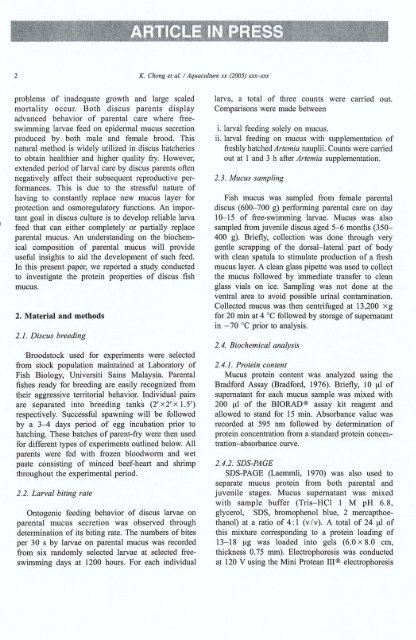Characterisation of proteins in epidermal mucus of discus fish ...
Characterisation of proteins in epidermal mucus of discus fish ...
Characterisation of proteins in epidermal mucus of discus fish ...
You also want an ePaper? Increase the reach of your titles
YUMPU automatically turns print PDFs into web optimized ePapers that Google loves.
2 K. Chong et al. / Aquaculture xx (2005) xxx-xxx<br />
problems <strong>of</strong> <strong>in</strong>adequate growth and large scaled<br />
mortality occur. Both <strong>discus</strong> parents display<br />
advanced behavior <strong>of</strong> parental care where freeswimm<strong>in</strong>g<br />
larvae feed on <strong>epidermal</strong> <strong>mucus</strong> secretion<br />
produced by both male and female brood. This<br />
natural method is widely utilized <strong>in</strong> <strong>discus</strong> hatcheries<br />
to obta<strong>in</strong> healthier and higher quality fry. However,<br />
extended period <strong>of</strong> larval care by <strong>discus</strong> parents <strong>of</strong>ten<br />
negatively affect their subsequent reproductive performances.<br />
This is due to the stressful nature <strong>of</strong><br />
hav<strong>in</strong>g to constantly replace new <strong>mucus</strong> layer for<br />
protection and osmoregulatory functions. An important<br />
goal <strong>in</strong> <strong>discus</strong> culture is to develop reliable larva<br />
feed that can either completely or partially replace<br />
parental <strong>mucus</strong>. An understand<strong>in</strong>g on the biochemical<br />
composition <strong>of</strong> parental <strong>mucus</strong> will provide<br />
useful <strong>in</strong>sights to aid the development <strong>of</strong> such feed.<br />
In this present paper, we reported a study conducted<br />
to <strong>in</strong>vestigate the prote<strong>in</strong> properties <strong>of</strong> <strong>discus</strong> <strong>fish</strong><br />
<strong>mucus</strong>.<br />
2. Material and methods<br />
2.1. Discus breed<strong>in</strong>g<br />
Broodstock used for experiments were selected<br />
from stock population ma<strong>in</strong>ta<strong>in</strong>ed at Laboratory <strong>of</strong><br />
Fish Biology, Universiti Sa<strong>in</strong>s Malaysia. Parental<br />
<strong>fish</strong>es ready for breed<strong>in</strong>g are easily recognized from<br />
their aggressive territorial behavior. Individual pairs<br />
are separated <strong>in</strong>to breed<strong>in</strong>g tanks (2' x2' x 1.5')<br />
respectively. Successful spawn<strong>in</strong>g will be followed<br />
by a 3-4 days period <strong>of</strong> egg <strong>in</strong>cubation prior to<br />
hatch<strong>in</strong>g. These batches <strong>of</strong> parent-fry were then used<br />
for different types <strong>of</strong> experiments outl<strong>in</strong>ed below. All<br />
parents were fed with frozen bloodworm and wet<br />
paste consist<strong>in</strong>g <strong>of</strong> m<strong>in</strong>ced beef-heart and shrimp<br />
throughout the experimental period.<br />
2.2. Larval bit<strong>in</strong>g rate<br />
Ontogenic feed<strong>in</strong>g behavior <strong>of</strong> <strong>discus</strong> larvae on<br />
parental <strong>mucus</strong> secretion was observed through<br />
determ<strong>in</strong>ation <strong>of</strong> its bit<strong>in</strong>g rate. The numbers <strong>of</strong> bites<br />
per 30 s by larvae on parental <strong>mucus</strong> was recorded<br />
from six randomly selected larvae at selected freeswimm<strong>in</strong>g<br />
days at 1200 hours. For each <strong>in</strong>dividual<br />
larva, a total <strong>of</strong> three counts were carried out.<br />
Comparisons were made between<br />
i. larval feed<strong>in</strong>g solely on <strong>mucus</strong>.<br />
ii. larval feed<strong>in</strong>g on <strong>mucus</strong> with supplementation <strong>of</strong><br />
freshly hatched Artemia nauplii. Counts were carried<br />
out at 1 and 3 h after Artemia supplementation.<br />
2.3. Mucus sampl<strong>in</strong>g<br />
Fish <strong>mucus</strong> was sampled from female parental<br />
<strong>discus</strong> (600-700 g) perform<strong>in</strong>g parental care on day<br />
10-15 <strong>of</strong> free-swimm<strong>in</strong>g larvae. Mucus was also<br />
sampled from juvenile <strong>discus</strong> aged 5-6 months (350<br />
400 g). Briefly, collection was done through very<br />
gentle scrapp<strong>in</strong>g <strong>of</strong> the dorsal-lateral part <strong>of</strong> body<br />
with clean spatula to stimulate production <strong>of</strong> a fresh<br />
<strong>mucus</strong> layer. A clean glass pipette was used to collect<br />
the <strong>mucus</strong> followed by immediate transfer to clean<br />
glass vials on ice. Sampl<strong>in</strong>g was not done at the<br />
ventral area to avoid possible ur<strong>in</strong>al contam<strong>in</strong>ation.<br />
Collected <strong>mucus</strong> was then centrifuged at 13,200 xg<br />
for 20 m<strong>in</strong> at 4 °C followed by storage <strong>of</strong> supernatant<br />
<strong>in</strong> -70°C prior to analysis.<br />
2.4. Biochemical analysis<br />
2.4.1. Prote<strong>in</strong> content<br />
Mucus prote<strong>in</strong> content was analyzed us<strong>in</strong>g the<br />
Bradford Assay (Bradford, 1976). Briefly, 10 III <strong>of</strong><br />
supernatant for each <strong>mucus</strong> sample was mixed with<br />
200 III <strong>of</strong> the BIORAD® assay kit reagent and<br />
allowed to stand for 15 m<strong>in</strong>. Absorbance value was<br />
recorded at 595 nm followed by determ<strong>in</strong>ation <strong>of</strong><br />
prote<strong>in</strong> concentration from a standard prote<strong>in</strong> concefltration-absorbance<br />
curve.<br />
2.4.2. SDS-PAGE<br />
SDS-PAGE (Laemmli, 1970) was also used to<br />
separate <strong>mucus</strong> prote<strong>in</strong> from both parental and<br />
juvenile stages. Mucus supernatant was mixed<br />
with sample buffer (Tris-HCI 1 M pH 6.8,<br />
glycerol, SDS, bromophenol blue, 2 mercapthoethanol)<br />
at a ratio <strong>of</strong> 4: 1 (v Iv). A total <strong>of</strong> 24 III <strong>of</strong><br />
this mixture correspond<strong>in</strong>g to a prote<strong>in</strong> load<strong>in</strong>g <strong>of</strong><br />
13-18 Ilg was loaded <strong>in</strong>to gels (6.0 x 8.0 em,<br />
thickness 0.75 mm). Electrophoresis was conducted<br />
at 120 V us<strong>in</strong>g the M<strong>in</strong>i Protean IIJ® electrophoresis








![[Consumer Behaviour] - ePrints@USM](https://img.yumpu.com/21924816/1/184x260/consumer-behaviour-eprintsusm.jpg?quality=85)








